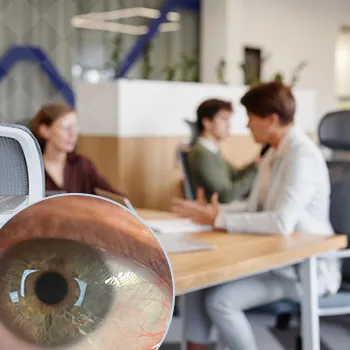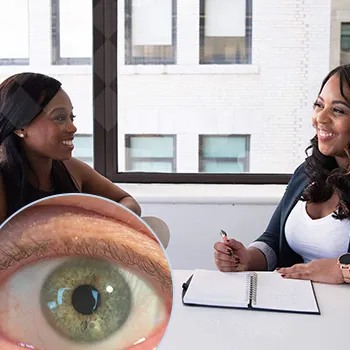Essential Childrens Eye Care Tips: How to Protect Young Vision
Table of Contents []
- Children's Eye Care Tips
- Understanding the Significance of Children's Eye Care
- Creating a Child-Friendly Eye Care Environment
- Incorporating Eye Care in Everyday Routines
- Navigating Vision Correction in Children
- Prioritizing Eye Safety During Activities
- Emphasizing Regular Eye Check-ups
- Supporting Your Child's Transition to Vision Aids
Children's Eye Care Tips
Understanding the Significance of Children's Eye Care

As a trusted resource in promoting healthy vision in children, we recognize the primacy of establishing a foundation for lifelong eye health. From the very first months of life, children's eyes are developing at a remarkable speed, making it all the more critical to ensure they receive proper care. Healthy vision contributes to their educational progress, their safety, and their ability to interact with the world around them.
Regular eye exams are a cornerstone of maintaining good eye health, helping to identify any concerns early on, from common refractive errors like nearsightedness or farsightedness, to more serious conditions. Besides these exams, there are everyday practices that can significantly influence eye health, such as nutrition, appropriate screen time, and protective eyewear during sports and outdoor activities.
We're here to support and guide parents and guardians through the crucial steps of children's eye care. With awareness and proper care, we can all contribute to our children's visual well-being. To assist further, we"ve developed the iTEAR100 device, designed to promote natural tear production and alleviate discomfort from dry eyes, a condition even children can experience.
Importance of Early Eye Exams
Early eye exams are not just about getting the right prescription for glasses or contact lenses; they can also help uncover hidden conditions that could potentially impair vision permanently if not treated promptly. Kids often don't understand what normal vision should look like, so they may not complain if they can't see well. That's why screenings are indispensable.
It's usually recommended that children have their vision screened during neonatal checks, again at preschool or early elementary age, and regularly throughout their academic career. Spotlighting any issues promptly could make the difference when it comes to treatment efficacy.
Daily Practices to Protect Your Child's Vision
Like any other part of the body, the eyes require care daily. Ensuring children spend time outdoors in natural light, take breaks during reading or screen time, and consume a diet rich in omega-fats and vitamin A can all pay dividends in the long run for their visual health.
Moreover, reminding kids not to rub their eyes excessively and to wear sunglasses to protect against UV rays are simple habits that can prevent eye health issues. We like to think of these practices as investments into your child's visual future.
Promoting Natural Tear Production
The iTEAR100 device, which our company proudly offers, is an innovative solution to stimulate the natural production of tears. While dry eyes might be more commonly associated with adults, kids can struggle with this too, particularly in today's screen-heavy environment.
The device works by sending gentle neuromodulation signals to the nerves around the nose, kick-starting the body's natural tear production without drugs or eye drops. This can be especially helpful for kids who might feel discomfort using traditional eye drops.
Recommended Frequency for Eye Exams
For infants, an initial eye screening is advised, followed by another check-up between 6 months to 1 year. Preschoolers should have their vision checked at 3 to 4 years and then again before entering first grade. School children without vision issues should continue to have their eyes tested every two years. However, children who need glasses or contact lenses may require more frequent monitoring.
Eye exams shouldn't just be a box-ticking exercise; they're preventative and proactive health measures. Think of them as routinely as you would dental check-ups or pediatrician visits.
Nutritious Foods for Vision Health
A balanced diet plays a pivotal role in overall health, including that of the eyes. Foods such as carrots, leafy greens, fish, and eggs provide the vital nutrients necessary for maintaining good vision. Eating a rainbow can help keep those eyes sharp and can often be a fun way to discuss health with children.
Zinc, Vitamin C and E, lutein, zeaxanthin, and Omega-3 fatty acids are just some of the essential eye-friendly nutrients found in a varied diet, helping protect against age-related eye problems later in life and supporting everyday eye function.
Creating a Child-Friendly Eye Care Environment

Children thrive under care that is consistent and tailored to their needs. The environment at home and school plays a significant role in their eye health. For instance, ensuring good lighting where they study can prevent eye strain, and teaching them to maintain a proper distance from screens can protect them from myopia.
Furthermore, it's essential to model good eye care habits ourselves, such as wearing sunglasses and using safety eyewear during certain activities, as children learn best by example. Creating an eye-friendly environment involves more than just physical adjustments; it includes fostering awareness about eye health from a young age.
At our company, we believe in supporting these environments with practical solutions. Our pocket-sized iTEAR100 device is an excellent addition to any child's eye care routine, especially for those experiencing dry eyes due to environmental factors or screen use.
Strategies for Reducing Screen Time
In this digital era, it's unrealistic to expect children to avoid screens entirely. However, moderation is key. Encourage breaks every 20 minutes to prevent eye fatigue, and make sure that screens are not the only source of entertainment for your children.
Creating a's creen curfew" well before bedtime can also help safeguard both their vision and sleep quality. Encourage non-screen activities, like outdoor play and reading physical books, to provide a healthy balance for their eyes and overall well-being.
Encouraging Outdoor Activities
Studies suggest that natural light and looking at distant objects can be beneficial for eye development, making outdoor play not only fun but healthy too. Plus, sports and outdoor activities promote social skills, physical health, and a respite from close-up focus, whether that's drawing or computer work.
It's not just about being away from screens; it's about actively enjoying an environment that naturally assists with maintaining healthy vision. Sports like soccer, basketball, or just a simple game of catch can be excellent for visual development.
Leveraging Protective Eyewear
Sports, science experiments, and even some types of play can pose risks to a child's eyes. Making sure they wear the appropriate protective eyewear can prevent serious injuries. Talk to them about the importance of protecting their eyes just like they would wear a helmet for riding a bike.
Keep in mind that protective eyewear should be comfortable, fit well, and, ideally, be part of the sports gear from the start, so it becomes a natural part of their gear up routine.
Tips for Maintaining a Healthy Learning Space
A well-lit, ergonomically designed learning space is conducive not only to studying efficiently but also to maintaining good eye health. A desk with a comfortable, supportive chair, positioned away from glare, can prevent unnecessary eye strain.
Consider investing in desk lamps with adjustable brightness and color temperature so that your child's work area is always optimally lit-neither too bright nor too dim.
Stop Your Dry Eye Now.

You're here because you have eye irritation or dryness, right? Well, you can stop having that problem. The iTear100 stops your dry eye in just seconds per use, AND you'll need it less as you use it! Click the image above - get relief now, and finally be free of dry eye issues for good!
Stop Your Dry Eye Now.

You're here because you have eye irritation or dryness, right? Well, you can stop having that problem. The iTear100 stops your dry eye in just seconds per use, AND you'll need it less as you use it! Click the image above - get relief now, and finally be free of dry eye issues for good!
Incorporating Eye Care in Everyday Routines

Good habits formed early can last a lifetime, and eye care is no exception. Emphasize the importance of hand hygiene before touching the eyes and remind children to blink regularly, especially when they are focused on a task like reading or using a device.
By integrating these simple eye care practices into their daily routines, children are less likely to develop issues and more likely to feel empowered to take control of their eye health. Everyday routines also provide a great opportunity to use the iTEAR100, especially if your child has been diagnosed with dry eye condition by a healthcare professional.
Developing these habits doesn't need to be dull-make it fun and engaging. Challenge your kids to blink contests or make a game out of spotting distant objects during walks, fostering both good eye health and lasting memories.
The Role of Hand Hygiene
Preventing eye infections starts with clean hands. Teach children to wash their hands regularly, particularly before touching their face or eyes. This not only applies to eye health but is a general health practice that can reduce the spread of germs.
Simple catchy songs or a timer can make handwashing an established routine rather than a chore. Use this as a teaching moment on how cleanliness affects different aspects of their health, including their eyes.
Blinking Exercises for Eye Moisture
Blinking is an automatic reflex, but when we focus intensely on activities like reading or using screens, our blink rate decreases significantly. This can lead to dry, tired eyes. Encourage children to practice conscious blinking to keep their eyes moist and refreshed.
Setting a timer to remind them to blink or having regular blink breaks" during homework time can be helpful strategies to nurture this habit.
Visual Games for Eye Development
Games that involve visual skills, such as puzzles, jigsaw, or memory games, can be not only entertaining but also beneficial for visual development. They stimulate different aspects of the visual system like focus adjustment, pattern recognition, and hand-eye coordination.
Remember, the goal is to keep it lighthearted and enjoyable. Kids are more likely to engage in activities that feel like play rather than work.
Making Eye Care Routines Fun
Making eye care routines engaging and fun ensures that they will be adhered to more readily. Simple rewards, stickers, or tracking charts can be great motivators for younger kids to follow through with eye care practices.
For older children, involving them in setting up their eye care routine, such as choosing their own protective eyewear for sports, can foster a sense of responsibility and ownership over their eye health.
Navigating Vision Correction in Children

When children are prescribed glasses or contact lenses, it can be a significant change for them. Our role as caregivers is to support and educate them on the importance of wearing their corrective lenses consistently, how to care for them, and of course, how to feel confident while wearing them.
Choosing frames that they like and that are comfortable can make the process smoother. For kids who are apprehensive, highlighting role models or storybook characters who wear glasses can be effective. It's all about showing them that glasses are a normal, positive part of life for many people.
Should your child experience dryness with contact lenses, the iTEAR100 device could provide a convenient solution. Our easy prescription and order system ensures that it can be delivered straight to your door, nation-wide. Remember, you can easily get in touch with us for new orders or any questions at 650-300-9340 .
Choosing the Right Glasses
Frames should be sturdy yet comfortable, and lenses should be made of impact-resistant material, especially for active children. Allow children to have a say in the style and color; if they like their glasses, they're more likely to wear them.
Also, educate them on caring for their glasses-cleaning, storing, and handling them properly. It can be turned into a sense of responsibility that they grow to appreciate.
Transitioning to Contact Lenses
As children grow, they may wish to transition from glasses to contact lenses, either for convenience or aesthetics. This transition should be guided by a healthcare professional who can evaluate if they're ready for the responsibility that comes with contacts.
Ensuring they understand the importance of hygiene and proper handling is key. It's a significant step towards autonomy in their own health care practices.
Addressing Dry Eye in Kids
Kids can experience dry eye too, possibly due to environmental factors or prolonged screen time. The iTEAR100 device is a non-invasive, convenient way to help mitigate these symptoms. It can be easily integrated into their morning or nighttime routine.
Just a few seconds each day can stimulate their natural tear production, potentially reducing the need for artificial tears and offering comfort.
Embracing Confidence with Vision Correction
Some kids might feel self-conscious about wearing glasses or using eye care devices. Encourage them to embrace their unique look and to appreciate the significant benefits these tools provide for their vision.
Positive reinforcement, sharing stories of successful people who wear glasses, or customizing their eyewear with stickers or charms can make them feel more at ease and even proud to sport their vision aids.
Prioritizing Eye Safety During Activities

Preventative measures can make a world of difference in eye safety. Whether it's for sports, recreational activities, or simply spending time outside, children should be equipped with the right protection for their eyes. Protective eyewear, such as goggles or shields, should be as common as knee pads or helmets in their safety kit.
Moreover, educating about potential hazards, like UV rays or blue light from screens, can foster a cautious approach to eye safety. Our company values the well-being of children's vision nationwide and is always prepared to provide guidance and solutions for eye care essentials.
For those times when protective measures aren't enough, and a child experiences discomfort or dryness, our iTEAR100 device offers a soothing, drug-free alternative for relief. It's simple to use and easy to integrate into any child's care routine, providing an additional layer of comfort for their precious eyes.
Choosing the Right Protective Eyewear
Selecting the appropriate eyewear for each activity is paramount. It should offer suitable protection, fit well, and conform to safety standards. Engaging kids in this selection process ensures they are more likely to wear them consistently.
Explain the different types of protective eyewear and when to use them. For example, sunglasses for UV protection, goggles for swimming, or polycarbonate lenses for high-impact sports.
Understanding the Risks of UV Exposure
UV exposure can damage the eyes as much as it can harm the skin. Wearing hats and UV-protective sunglasses during peak sun hours can significantly decrease this exposure risk for children.
Make it a habit to bring their protective gear when heading out, just like you would with sunscreen. Building this habit in kids from a young age can have a lasting impact on their eye health.
Educating about Blue Light
With the prevalence of screens in today's world, educating kids about the potential impacts of blue light is essential. While the research on its long-term effects is still ongoing, encouraging regular breaks and maintaining a safe viewing distance can prevent eye strain.
There are also screen protectors and glasses with blue light filtering capabilities that can be used when prolonged screen exposure is inevitable.
Tips for Preventing Sports-Related Eye Injuries
Sports can be an excellent way for kids to stay active and healthy, but eye injuries can be a risk in many physical activities. Ensure children wear the correct protective gear and understand not to run or play roughly near sharp objects or uneven surfaces.
It's about being conscious without causing fear-informing them of the risks and how to avoid them while still enjoying the game.
Emphasizing Regular Eye Check-ups

Regular eye check-ups should be as routine as visiting the dentist or the pediatrician. These appointments are not only about ensuring proper vision; they're a comprehensive assessment of eye health, which is an integral part of overall well-being.
We are committed to informing parents about the importance of these appointments and supporting them in finding the best care for their children, including state-of-the-art solutions like our iTEAR100 device. For questions, reorders, or new orders, please feel free to reach out to us at 650-300-9340 . We're here, serving everyone nationwide, ready to help ensure the visual health of the next generation.
Spotting Signs of Vision Problems
Be vigilant of signs that might indicate vision problems in children: squinting, sitting too close to the television, frequent eye rubbing, or an apparent difficulty in reading or seeing distant objects. These cues can suggest it's time for a check-up.
Early detection and treatment are critical in correcting vision problems and preventing long-term issues, so don't hesitate to make an appointment if these signs arise.
Preparing Your Child for an Eye Exam
Make eye exams a stress-free experience. Talk to your child about what will happen during the appointment, and assure them that you'll be with them throughout the process. Being calm and collected yourself can significantly ease their anxiety.
Also, choose an eye care professional who is experienced in working with children to make the experience as comfortable as possible.
Understanding the Different Types of Eye Tests
Be familiar with the various eye tests that your child might undergo, such as visual acuity tests, refraction assessments, and ocular health examinations. Knowing these can help you explain them to your child beforehand to demystify the experience.
If your child has been diagnosed with an eye condition that causes dryness, talk to the eye care professional about the possibility of implementing the iTEAR100 in their routine.
Maintaining an Eye Health Record
Keep a record of your child's vision health, including a history of eye exams, any prescription changes, and any eye conditions or treatments. This record will be beneficial whenever you visit new specialists or need to track the progression of their eye health.
It's a simple step that provides a significant advantage in managing and understanding your child's visual development over the years.
Stop Your Dry Eye Now.
You're here because you have eye irritation or dryness, right? Well, you can stop having that problem. The iTear100 stops your dry eye in just seconds per use, AND you'll need it less as you use it! Visit iTear100.com to learn more!
Supporting Your Child's Transition to Vision Aids

Introducing any new routine can be challenging for children, especially when it comes to vision aids. Whether it's glasses, contact lenses, or therapeutic devices like the iTEAR100, it's important to demonstrate patience and provide support.
We encourage parents to show enthusiasm for the positive changes these aids can bring to their child's life. By normalizing the use of vision aids and celebrating their benefits, children will be more accepting and compliant with their use.
Don't hesitate to contact us for additional information or support regarding eye care products and how to integrate them into your child's life. Our team is dedicated to serving families nationwide, and we can be reached at 650-300-9340 for any queries you might have.
Making Adjusting to Glasses a Positive Experience
Pick out frames together, and try to make it as enjoyable as shopping for a new outfit. Reinforce the idea that glasses are a tool that
Previous Page
